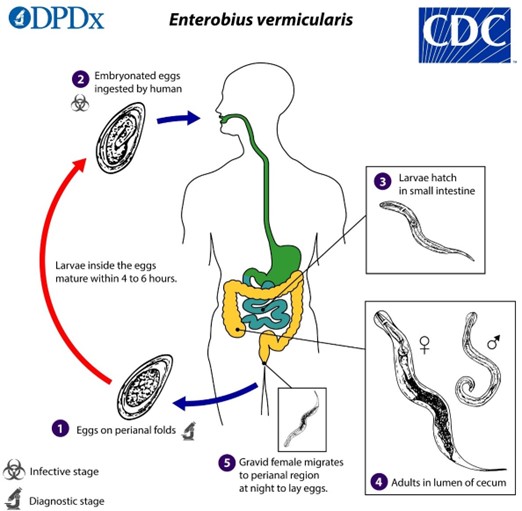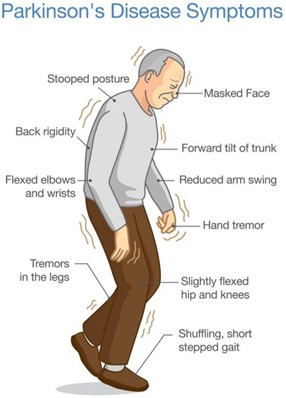A nurse is reinforcing teaching with the guardian of a preschooler who has a new diagnosis of enterobiasis.Which of the following information should the nurse include in the teaching?
a. "One dose of medication is all that will be necessary."
"Everyone who lives in the home will need medication."
"Allow the child to take tub baths instead of showers."
"Wash all clothes and bed linens in cold water."
The Correct Answer is B
b. "Everyone who lives in the home will need medication."
The nurse should inform the guardian that everyone who lives in the home will need medication when reinforcing teaching about enterobiasis. Enterobiasis, also known as pinworm infection, is highly contagious, and it can easily spread from person to person within the household. Treating only the affected individual may not be sufficient to eliminate the infection completely, as other household members may also be infected or at risk of reinfection.
Explanation for the other options:
a. "One dose of medication is all that will be necessary." Enterobiasis is typically treated with a medication regimen that involves taking multiple doses over a period of time. This is to ensure that all stages of the pinworm life cycle are targeted and eradicated. A single dose is usually not sufficient to eliminate the infection completely.
c. "Allow the child to take tub baths instead of showers." The choice of tub baths or showers does not directly impact the treatment or prevention of enterobiasis. Both methods of bathing can be used, but it is important to maintain good hygiene practices, such as regular handwashing and proper cleaning of the perianal area, to reduce the risk of reinfection.
d. "Wash all clothes and bed linens in cold water." While proper hygiene practices and laundering of clothes and bed linens are important in preventing the spread of enterobiasis, using cold water alone may not be sufficient. Washing clothes and bed linens in hot water (at a temperature of at least 60°C or 140°F) is recommended to kill any pinworm eggs that may be present.

Nursing Test Bank
Naxlex Comprehensive Predictor Exams
Related Questions
Correct Answer is B
Explanation
b. Keep suction equipment at the client's bedside.
The nurse should plan to include keeping suction equipment at the client's bedside as an intervention for a client with Parkinson's disease. Parkinson's disease can cause dysphagia (difficulty swallowing) and an increased risk of aspiration. Having suction equipment readily available allows for prompt intervention in case of choking or aspiration episodes, ensuring the client's safety.
Explanation for the other options:
a. Restrict the client's fluid intake: Restricting the client's fluid intake is not typically indicated in the care of a client with Parkinson's disease. Adequate hydration is important for overall health and well-being. However, specific fluid restrictions may be necessary in certain situations, such as if the client has coexisting conditions like heart failure or kidney disease, which should be assessed and determined by the healthcare provider.
c. Instruct the client to look down when ambulating: In Parkinson's disease, individuals often experience a forward-flexed posture and a shuffling gait. Instructing the client to look down when ambulating is not an appropriate intervention. Instead, the nurse should encourage the client to maintain an upright posture, take smaller steps, and focus on taking deliberate and controlled movements to promote stability and reduce the risk of falls.
d. Position the client supine after eating: Positioning the client supine after eating is not recommended for a client with Parkinson's disease. This position can increase the risk of aspiration, as it may promote reflux and regurgitation of stomach contents. Instead, the nurse should advise the client to maintain an upright position, such as sitting in a chair or using a recliner with appropriate head support, to aid digestion and reduce the risk of aspiration.

Correct Answer is B
Explanation
b. Platelet count 90,000/mm3.
Explanation:
During pregnancy, it is important to monitor the client's platelet count because a low platelet count can indicate a condition called gestational thrombocytopenia or other potential complications such as preeclampsia or HELLP syndrome. A platelet count of 90,000/mm3 is lower than the normal range and should be reported to the provider for further evaluation and management.
Option a, Hgb 12 g/dL, falls within the normal range for hemoglobin during pregnancy, which is typically between 11-13.5 g/dL. Therefore, it does not require immediate notification to the provider.
Option c, Hematocrit 37%, also falls within the normal range for hematocrit during pregnancy, which is typically between 33-42%. Therefore, it does not require immediate notification to the provider.
Option d, Creatinine 0.7 mg/dL, is within the normal range for creatinine levels and does not indicate any immediate concerns or need for notification to the provider.
It is important to remember that the interpretation of laboratory results should be done in the context of the client's individual clinical presentation and the healthcare provider's assessment. Any concerns or abnormal findings should be communicated to the provider for further evaluation and appropriate management.
Whether you are a student looking to ace your exams or a practicing nurse seeking to enhance your expertise , our nursing education contents will empower you with the confidence and competence to make a difference in the lives of patients and become a respected leader in the healthcare field.
Visit Naxlex, invest in your future and unlock endless possibilities with our unparalleled nursing education contents today
Report Wrong Answer on the Current Question
Do you disagree with the answer? If yes, what is your expected answer? Explain.
Kindly be descriptive with the issue you are facing.
